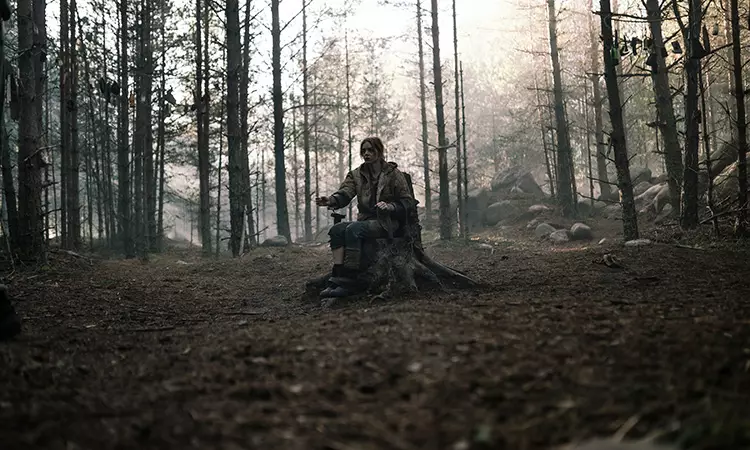The film “Azrael: Angel of Death,” directed by E.L. Katz and written by Simon Barrett, presents a haunting exploration of the post-apocalyptic landscape draped in religious and existential symbolism. From the beginning, the film establishes its eerie tone with the striking red text declaring, “Many years after the Rapture…” This alone signifies that the narrative delves deep into themes of salvation, damnation, and the human condition navigating through the remnants of a society that has fractured under the weight of its convictions.
The imagery employed in “Azrael” is striking and multifaceted, beginning with the opening scene set inside a candle-lit church. As viewers are introduced to a new religious order led by a pregnant matriarchal priestess, the symbol of the church gains an unsettling feminist twist that subverts traditional patriarchal structures. This church is not merely a shelter of hope but rather a purgatorial institution wrestling with the complexities of faith guided by fear. The suggestive visuals—like the bloodstained wall—point toward a society that has reverted to more visceral, primal rites, reflective of a human sacrifice culture that underscores desperation.
What stands out is how the film uses the church as a microcosm of this new world. It becomes a sanctuary plagued by survivalist ideologies, where the community adheres to radical beliefs to fend off lurking dangers, both external and internal. This tension manifests in a language of violence and ritual that propels the narrative forward. The absence of verbal communication, with characters surrendering their right to speech, highlights the deep-seated fear that has enshrouded this society. Not only is this post-apocalyptic existence devoid of the spoken word, but it also signifies a regression into a state of primitive instincts, as if language itself had become a forbidden fruit in their fractured reality.
Symbols of Survival and Rebirth
The film’s central character, a young woman referred to as Azrael (played by Samara Weaving), embodies the struggle for agency amidst chaos. After being abducted and forced to confront the violent acts of a monstrous force, Azrael must navigate a world turned hostile while simultaneously seeking justice for the injustices inflicted upon her. However, her journey transcends mere survival; it becomes a visceral commentary on how trauma can transform an individual into a weapon of vengeance.
As Azrael traverses through this treacherous landscape, the religious motifs of crucifixion and resurrection come into play, albeit with an insidious twist. Where traditional narratives might celebrate revival and redemption, “Azrael: Angel of Death” chooses to invert these images, presenting a different kind of rebirth—one that is rooted in violence and vengeance rather than hope. This leaves audiences to ponder the implications of survival in a world devoid of morality and order. Is Azrael the savior she appears to be, or does her emergence signal the rise of a more daunting threat disguised as an angelic figure?
The narrative culminates in a vivid tableau that challenges the viewer’s allegiance. The film draws parallels to today’s society, inviting contemplation on the polarized nature of sacred and secular ideologies. In a world where moral compasses are rapidly shifting, and the boundaries between good and evil blur, the ultimate question remains: Do the ends justify the means? At what point does the desire for survival lead one down a path of destruction, and how does that speak to our collective psyche in times of crisis?
As the film unfolds, it intertwines horror with profound philosophical inquiry. The raw, primal essence of the characters serves as a reminder that even in a world engulfed by darkness, the struggle for identity, agency, and morality persists.
Ultimately, “Azrael: Angel of Death” portrays a fragmented society grappling with its demons, leaving viewers to tread carefully as they navigate their own beliefs in an increasingly chaotic world. By embracing the chaos and exploring its themes of sacrifice, power, and the consequences of our choices, this film stands as a gritty testament to the complexities of the human experience amid the apocalypse.


Leave a Reply